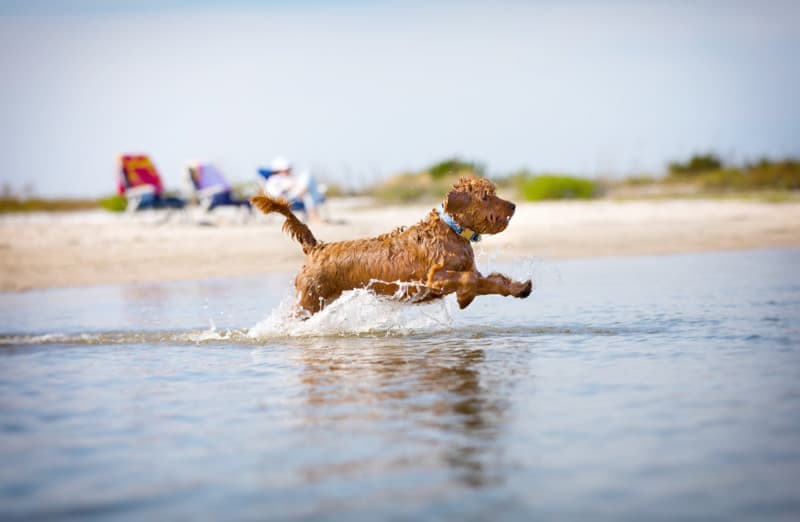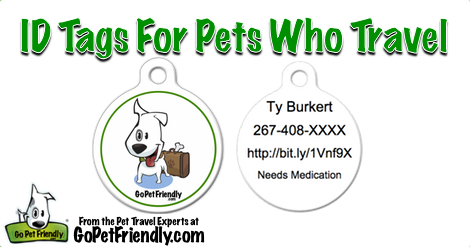If your pet goes missing while traveling, how do you find them quickly? The obvious place to start is with a good ID tag. And with a few tips, you can make your pet’s ID tag even more helpful!

Challenges of Lost Pets While Traveling
Any time a pet goes missing, it’s scary. But if it happens while you are traveling, it is an absolute nightmare.
You don’t have the benefit of friendly neighbors who can keep an eye out while walking their dogs. You’re not hooked into the local social media sites. And there’s little hope your furry family member will find their way back to your hotel or campsite on her own.
Hopefully you’ve microchipped your pets. And have tags on their collars. But a tag with your phone number won’t help much if you’re traveling through a cell phone dead zone.
However, if you upgrade your standard pet ID tag, you’ll make it more likely to be reunited. Let’s show you how.
READ MORE ⇒ Keep Your Pet From Getting Lost While Traveling

A Better ID Tag If Your Pet Goes Missing
The key to a better pet ID tag is to use technology. Instead of just putting your name and phone number on your pet’s tag, add a URL to a personal web page.
Anyone who finds your pet will have access to the vital information they need to care for your pet temporarily and get them back home to you. Helpful details you might include on a website include:
- your current location (campsite, hotel, etc.)
- a backup contact in case you can’t be reached
- information about your pet’s medical conditions
- behavioral issues like fear of people or other dogs
- diet restrictions.
You can even add information about the last place someone spotted your dog. Or share details of a reward you’re offering for their return. And the web page is easily accessed via a smartphone, tablet, or computer.
Setting Up Your Pet ID – The Website
If you already have a blog to share your travels, you’re golden! Just create a new page (make it private so it doesn’t show up in search results). Add the details and hit publish.
When we traveled full time, I set up a page each for our then-travel partners, Ty and Buster. Here’s what Ty’s page looked like:

Making A Lost Pet Web Page
If you don’t already have a website (or have a friend who has a blog) where you can add a “Lost Dog” page, here are a few places where you can set one up for free:
- Blogger (owned by Google so it’s easy to set up if you already have a Gmail account)
- WordPress
- Wix
- Weebly
If you’d like more detailed instructions to set up a free site on Blogger, WordPress, or Wix, check out What if Your Dog Got Lost in a Cell Phone Dead Zone.
All of these free sites are easy to set up. And if you enjoy it, maybe it will lead to you creating an online record of your travels.
READ MORE ⇒ What If Your Dog Got Lost In A Cell Phone Dead Zone?
Shorten The Link
Once you have your “Lost Pet” page set up, you’ll have a long url that brings you directly to that page. For example, the url for this blog post is: https://www.gopetfriendly.com/blog/thats-how-we-roll-id-tags-for-traveling-pets
Obviously, that’s too long to fit on an ID tag, so you’ll need a url shortener like bitly to give you a clipped, unique url that works the same way as the long one. This is what the shortened url for this blog post looks like: http://bit.ly/1Vnf9Xk – much handier for fitting on an ID tag!
Make the Pet ID Tag
Purchasing an ID tag and engraving it in the pet store is quick and easy.bBut if you are looking for a bit more selection in designs – or want to design your own pet ID tag – shopping online provides more options. I used DogTagArt.com to customize dog tags for Ty and Buster with their new “Lost Dog” urls on the back. This is what Ty’s looked like:

Maintain The Pet Tag Info
Now, remember to update the information as you travel. After all, a Good Samaritan cannot return your dog to you if your website shows the campground you left two weeks ago.
Share instructions for updating your website with a trusted friend or family member. A quick call to your emergency backup allows you to look for your pet while someone else updates the information on the site for you.

Email Alternative Pet ID Tag
When I first wrote this article a few years back, we got some great suggestions in the comments from other pet travelers.
Shout out to Elisa B. She suggested another way to make your pet’s ID tag smart—add an email address in addition or or instead of a web URL. Then set up an auto response to anyone who emails you.
The auto responder should include your contact information, backup contact person, and your vet contact. Add the suggestion that your pet’s finder contact local law enforcement for help using the microchip to help reunite you.
Remember to set up a unique email address for your pet’s tag. Otherwise, every personal email you receive will reply with a note about your pet.
And remember to update the auto response as you travel. Once again, if you find yourself in a cell phone dead zone or without internet, you will want someone to know where to find your campsite.
Search online for instructions to set-up an auto response in your favorite mail service. Here are guidelines for some of the most popular email services:

Update Your Pet ID Tag Now
Do not wait to update your pet’s ID tag. Dogs and cats can go missing at any time. Even if you are not on vacation, you pet could go missing while in the care of a pet sitter or family member.
Give them every chance to return home! Make it easy for the army of animal lovers who look out for missing pets (I do; I suspect you do, too) to reunite you with your lost pet.








